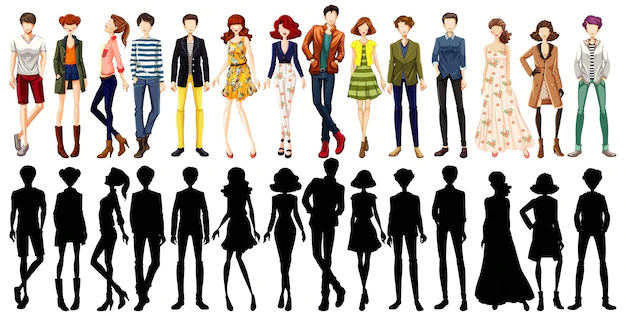Finding Your Perfect Swimsuit: A Body-Type-Specific Approach to Swimwear Selection
The summer season necessitates the selection of appropriate swimwear for both comfort and aesthetic appeal. This guide provides a structured approach to swimsuit selection, integrating principles of body image, fashion psychology, and consumer behavior to facilitate the acquisition of flattering and confidence-boosting swimwear. Key concepts such as body shape identification, the application of color theory, and the understanding of fit and support will be explored, offering a comprehensive strategy for swimsuit selection.
Body Shape Analysis: A Foundation for Swimsuit Selection
Effective swimsuit selection commences with a thorough understanding of one's body shape. This involves recognizing the distinct proportions of the body, classifying it into categories such as hourglass, pear (triangular), apple (inverted triangle), rectangle, and inverted triangle. This classification is not solely based on visual observation but can be enhanced by anthropometric measurements – utilizing tape measure to assess key dimensions like bust, waist, and hip circumference – offering a more objective assessment. The accurate identification of body shape is crucial as it forms the basis for choosing swimsuit styles that will accentuate advantageous features and minimize perceived flaws. Online resources and consultations with image consultants can further enhance the accuracy of this assessment, aligning with the principles of self-perception and body image management discussed in social psychology literature.
Strategic Swimsuit Design: Enhancing Assets and Minimizing Perceived Imperfections
The selection of swimsuit styles directly aligns with the principles of visual perception and the Gestalt principles of design. Following body shape identification, styles should be chosen to optimize the visual presentation of the body. For example, individuals with an hourglass figure might choose swimsuits that emphasize the waistline using defined waistbands or cinched designs, drawing upon Gestalt’s principle of closure to emphasize the waist-to-hip ratio. Similarly, individuals with pear-shaped bodies can utilize high-waisted bottoms or A-line designs to visually balance proportions. Conversely, individuals with apple-shaped bodies might choose swimsuits that draw attention upwards, using details such as ruffles or embellishments on the bust or neckline to shift visual focus. These strategies minimize perceived imperfections by strategically guiding the viewer's attention, adhering to the principles of design psychology.
The Role of Chromatics and Pattern in Shaping Perception
Color theory plays a significant role in shaping the perceived silhouette. Darker colors, such as navy, black, and deep jewel tones, tend to have a slimming effect, minimizing perceived body volume. Conversely, lighter colors and bold patterns draw attention to specific areas. This aligns with the principles of chromatics in art and design, illustrating how color choices can influence the perception of shape and size. The strategic use of patterns – vertical stripes for a lengthening effect or horizontal stripes to create an illusion of curves – adds another layer of control. It's crucial to choose colors that complement individual skin tones, amplifying personal radiance and enhancing overall aesthetic harmony. The selection of color and pattern is thus a strategic design process intended to optimize visual appeal.
Support and Fit: Prioritizing Comfort and Confidence
The importance of proper support and fit cannot be overstated, aligning with the principles of ergonomics and consumer satisfaction. Swimsuits, particularly for individuals with larger busts, necessitate features like underwire, adjustable straps, and built-in cups to ensure comfort and security. This functionality is directly related to the comfort and confidence levels of the wearer. A well-fitting swimsuit contributes significantly to a positive body image and enhances self-esteem. The choice of fabric also influences comfort and support, with materials like Lycra offering excellent elasticity and shape retention. Considering these factors ensures a swimsuit that not only looks good but also feels good, maximizing wearer satisfaction.
Swimsuit Style Exploration: Adapting to Individual Body Types and Preferences
A range of swimsuit styles caters to diverse body shapes and preferences, and the selection should be informed by body type analysis and personal preferences. One-piece swimsuits, known for their versatility, can incorporate design elements such as cutouts or high-cut legs to enhance specific features. Two-piece swimsuits allow for greater customization through the selection of separate tops and bottoms. High-waisted bottoms can create a flattering silhouette and provide tummy control. Swimsuits with asymmetrical designs, such as one-shoulder styles, offer a modern aesthetic and can enhance specific aspects of the body shape. Trial and error is crucial; exploration of various styles leads to a better understanding of personal preferences and what works best for each individual.
Beyond the Swimsuit: Accessories Enhancing Overall Beach Style
Swim dresses and cover-ups add another layer of versatility and style, providing additional coverage and extending the range of beach outfits. Swim dresses offer a polished look while maintaining comfort and enhancing coverage around the hips and thighs. Cover-ups, such as sarongs, provide flexibility, allowing for effortless transitions between swimming and other activities. This creates a more cohesive and functional beach wardrobe, ensuring comfort and style throughout the day. This diversification of options maximizes the overall use and enjoyment of the swimwear.
The Crucial Role of Trial and Fitting in Swimsuit Selection
The significance of trying on swimsuits before purchase cannot be overemphasized. Sizing variations among brands necessitate a physical fitting to ensure optimal fit and comfort. Direct physical interaction with the garment allows for evaluation of the garment’s drape, support, and overall fit against the body. This process allows for immediate feedback and adjustments, enhancing the likelihood of selecting a truly flattering and comfortable swimsuit. This aligns with the principles of consumer decision-making and ensures product satisfaction.
Confidence: The Ultimate Swimsuit Accessory
Ultimately, confidence is the most powerful element contributing to the perceived attractiveness of a swimsuit. Self-acceptance and positive body image foster an aura of confidence that transcends stylistic choices. Embracing individuality and valuing one's unique body shape empowers individuals to choose swimsuits that reflect their personal style and create a feeling of self-assurance. This confidence translates into enhanced self-perception and overall well-being, adding a dimension of personal style that surpasses mere aesthetic considerations.
Conclusion and Recommendations: Optimizing Swimwear Selection and Future Research
Effective swimsuit selection involves a multi-faceted approach integrating body shape analysis, strategic design principles, and understanding of color theory, fit, and support. Prioritizing comfort and choosing swimsuits that enhance individual confidence are paramount. Further research could explore the impact of different swimsuit styles on body image perceptions and explore the cultural influences on swimsuit preferences. The development of standardized sizing systems across brands would enhance the consumer experience and minimize the challenges associated with inconsistent sizing. The integration of virtual fitting technologies could potentially revolutionize the online purchase experience, providing users with more accurate representations of how a swimsuit will fit.
Reader Pool: What aspects of this guide do you find most helpful in navigating the process of swimsuit selection, and what additional factors might influence your decision-making process?





